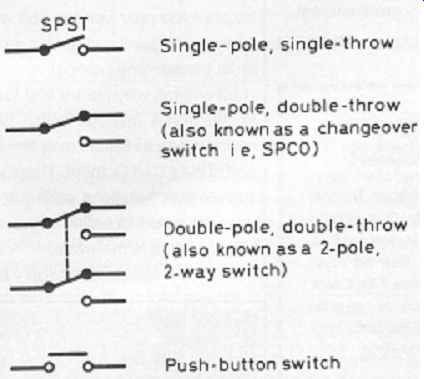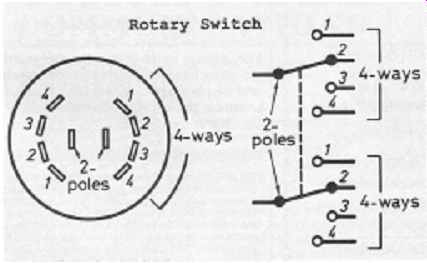AMAZON multi-meters discounts AMAZON oscilloscope discounts
Simple, but be careful! A switch is the simplest electronic component, but care is needed in choosing the correct one for the job. Here is a list of the main characteristics of a switch, which will help you to select what you want.
1. Rating. This gives the maximum voltage and current that a switch can handle. For example, a 250V 1.5A switch will switch mains voltage at a current not exceeding 1.5A. If the current is greater than 1.5A, the switch may get hot and fail. If the voltage is too great, the switch may arc each time it is switched off, thus wearing away the contacts.
2. Number of poles. A single switch can control many circuits; the number of poles tells you how many different circuits it can handle.
See Figure 1.
3. Number of throws. This tells you the number of positions each pole can have. This is best illustrated in Figure 1. The simplest ON/OFF switch is a Single-Pole, Single-Throw (SPST) switch. A Single-Pole, Double-Throw (SPDT) switch may also be used as an ON/OFF switch, but is used mainly to change between two parts of a circuit, and is commonly known as a Single-Pole Change-Over (SPCO) switch.
Two or more SPCO switches can be operated at once; Figure 1 shows an example. The two switches are said to be ganged. See also 'Types of switch' below.
4. Number of ways. When a switch has more than one throw, we tend to use the word 'ways' instead. This means that if a switch has one pole and six throws, we would normally call it a '1-pole 6-way' switch.
Such switches tend to be rotary switches, as are described below.

Figure 1 Some circuit symbols for different types of switch

Figure 2 The rotary switch can select several different circuits at once
Types of switch
(a) Push-button. These are found on calculators, telephones, electronic games and most equipment with a digital display.
(b) Rotary. These are switches controlled by a knob, and are turned instead of moved up and down. Figure 2 shows the rear of such a switch and its circuit symbol. The commoner types of rotary switch are: 1-pole, 12-way; 2-pole, 6-way; 3-pole, 4-way; 4-pole, 3-way; 6-pole, 2-way. All these switches have 12 click positions, as you may have guessed, but each one comes with an adjustable end-stop so that you can set the correct number of ways according to the contacts on the switch.
(c) Slide. This switch is common on the cheaper types of radio, mainly as an ON/OFF or band-changing switch. They are not very rugged, but are small and cheap to produce. Very small types are manufactured for use on PCBs.
(d) Toggle. Available as two-way types or three-way, with a center-off position. Can be manufactured to handle very high currents.
(e) Micro-switch. These are devices which are usually operated indirectly, such as when the cover is removed from a high-voltage power supply, or when the door of a fridge is opened. The 'micro' part of the name doesn't refer to the size of the switch, but to the small movement that is required to activate it.
